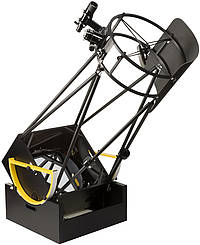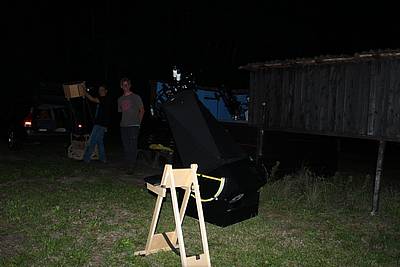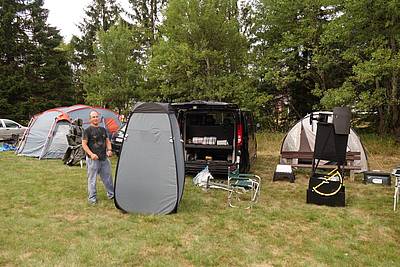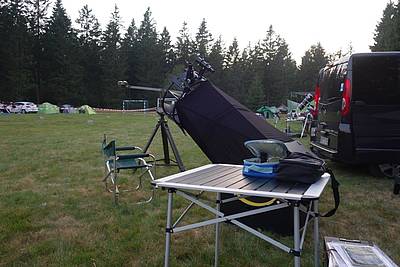There was not much to think about. The offer from EXPLORE SCIENTIFIC to use the big 20" Dobson for a few nights was too tempting. And so at the end of July 2019 the exhibition equipment was loaded from the halls of BRESSER/EXPLORE SCIENTIFIC into the car and transported to neighbouring city of Borken. Loading is the right expression. The telescope is really no longer a handy device. The total weight of 53 kg, with the heaviest part being the mirror box with a good 35 kg, makes the telescope borderline for the sole superstructure. It is just not a device that you can quickly put outside. The transport in a small car is however well possible. The solid lattice tube construction in black-yellow kept, rushed in the trunk of my car over the B67 road in the direction of my home. In expectation of a clear night I was curious about the picture that this Dobson device would give me. So far I could use "only" telescopes up to 16 inch aperture. I myself own a 10 inch Dobson telescope, which has to be used as a comparison device. Admittedly, it is an unequal duel between David and Goliath. Arrived at home I unloaded the heavy mirror box and the lower part of the rocker box. I placed the device on the place for the night. A later location change was not conceivable because of the weight and the size. It is advisable to assemble the device in pairs. To combine the tube trusses and the hat with the mirror holder with the rest of the device is not easy. Two hands were not enough.
Review EXPLORE SCIENTIFIC 20" F/3.6 DOBSON TELESCOPE
A review written by Christian Overhaus Member of the Sternfreunde Borken e.V. in GERMANY
I looked for the other way and screwed the struts to the hat, which was no problem at all. Then the whole construction could be put nicely on the mirror box and screwed. Five minutes later the construction stood. Now still fast the glare shield and the black tube cloth attached, was finished the telescope. It is already an impressive device. The main mirror with a diameter of 50 cm makes the 10 inch next to it look like a toy. When I think about it that my first look into the depths of the cosmos happened with a telescope whose mirror had a diameter of only 115 mm!
I waited anxiously for the night. After nightfall I began to align the two mirrors of the telescope with the adjusting laser. The secondary mirror can be moved very easily at two knurled screws, so that the laser point in seconds reaches the center marking of the main mirror. The main mirror can be adjusted from the top with three adjustment screws. An approx. 90 cm long special adjustment tool (long Allen key) is included in the scope of delivery. The simultaneous view through the telescope during the adjustment is thus possible. The adjustment itself is no problem and went very fast. But I am already moderately trained in it. If you have set up the device several times, I could imagine that you can use it within a quarter of an hour from the trunk. But a second person is indispensable.
The first night with the telescope at home was a great pleasure. At the edge of a small town living with the agglomeration Ruhrgebiet in the south, the sky here at the location is not outstandingly good. SQM measurements reach sky luminosities of 20.8 to 20.85 mag at the zenith. So it was also late in the following night. At first it was not completely cloudless and at the beginning maybe a bit hazy. Especially at the end of July it was dark late. The device could not show its full performance.
The Jupiter was the first one, which I could observe with the telescope. First in the 7.5mm eyepiece, later at the same magnification in a binocular-viewer. Despite the low position of the planet in the constellation Scorpio and with bad seeing, the sight was simply great. The Dobson provided a beautiful bright image, the cloud strips showed beautiful structures and the Great Red Spot clearly showed its color. The small 10 inch telescope showed in principle the same, but smaller, because of the shorter focal length of the telescope (1800 mm to 1250 mm). And the picture was of course much brighter in the 20 inch. The light gathering area is four times as large. The saying of Dobsonauts that opening can only be topped by more opening was impressively proven at this point. Until the real darkness, I enjoyed the view of the distant planet, which was 690 million kilometers away from me that evening. With the telescope I could reach him up to two and a half million kilometres.
The pleasure of observing with a Dobson telescope does not depend exclusively on the aperture. At least as important is the good tracking and stability of the telescope. The 20" Dobson, a high-end instrument made in Hungary and Germany, is beyond all doubt in this respect. The technical demand is much higher because of the size of the telescope and the higher magnification. The small 10" Dobson is mounted on Teflon pads which slides over an Ebony Star surface. This combination has proven to be ideal for the Dobsonauts. Unfortunately, the Ebony Star material is only available in limited quantities because the manufacturer discontinued production. EXPLORE SCIENTIFIC relies instead on a kind of corrugated sheet made of glass fibre reinforced plastic (GFK). In practice, it is somewhat more difficult to move the 20 inch with more force than the smaller machine. However, its stiffness and stability are surprisingly good in any position. Tracking at 260x magnification with the Binocular-viever was no problem at all. In spite of the large mass that had to be moved there, the tracking was done sensitively. I didn't even have to use the attached counterweights to compensate for overloads.
By the way, you can find the objects with a Telrad or a 8x50 viewfinder. Both were mounted on this 20 inch. Note: Telrad finder is an optional accessory and not included in regular delivery. I am experienced with the Telrad finder and got along with it quite well. The search in the ten inch is a bit easier, because weight and gliding ability of the mount require less effort, but also the big one can be led quite well to the target objects.
The additional effort compared to the 10 inch is rewarded with a much brighter picture. One of the first targets this evening is the globular cluster Messier 13 in Hercules. This is already a feast for the eyes in 10 inch. In the 20 inch he is breathtaking. The 7 inch eyepiece shows it format-filling, thousands of stars, hairpin fine. Also here the Binocular-viever can increase the observation experience again. Two eyes just see more. And the beautiful floating star ball in 25000 light years distance is one of the most beautiful views of the northern star sky. One of my favourite destinations in the summer sky is the Cirrus Nebula in the Swan. At a late hour, when it was sufficiently dark, I reached for the overview eyepiece. I achieved the necessary contrast to the sky background through a UHC filter. The beautifully structured fog remains of a supernova explosion came out very well even under a small town sky. One has to say, the 10 inch telescope, which practically has an integrated filter wheel with UHC and OIII filter, didn't look bad either. The visibility of such objects is as strongly bound to the quality of the sky as to the optics used.
The 20 inch had a clear advantage while observing the planetary nebula Messier 76. I've never seen such a beautifully structured nebula before. Also the many small stars around it impressed me. Compared to the 10 inch it's probably like taking off your sunglasses.
Very nice, I'd say.
That evening I could still observe Saturn, which was positioned close to the horizon in the Sagittarius constellation. The left impression corresponds to the observation of Jupiter. The Cassini division in the Saturn ring was very clearly to be seen, also the shadow of the planet on the ring system showed up clearly.
Another highlight, I think, was the double star cluster Hi and Chi Persei in the constellation Perseus. In the used 30mm eyepiece both clusters just fit into the field of view. The many stars are already a heavenly sight, extremely beautiful...
At the end of August 2019 the telescope was allowed to travel into the Harz Mountains to the St. Andreasberger telescope meeting. There, at a height of 700 m above sea level with an excellent sky, the telescope was able to show what it was capable of. After all, a sports car is not only tested on dirt roads but also on a racetrack. The sky over St. Andreasberg reached a darkness of 21.56 mag/arcs. So it is only half as bright there as in my hometown Borken. For the stargazers the sight of the magnificent Milky Way with the naked eye is already a pleasure. But the large 20 inch telescope made cosmic landscapes visible that make the heart of the stargazer beat faster. The already inspected Cirrus Nebula looked like a painting. The telescope's optics could also reproduce the image quality of a high-quality eyepiece with an 82-degree field of view. I was particularly impressed by the Crescent Nebula NGC 6888. If it is almost difficult to see the brightest filaments at home, the full crescent literally caught your eye. The galaxies around NGC 7331 and Stephan's quintet also became easy prey. Under these conditions, observation with a large 20 inch telescope was a fascinating affair. No wonder that large telescopes meet with great interest during the telescope meetings.
Is the purchase of such a large device worthwhile? I was skeptical, to be honest. The effort to setup a 20 inch truss tube telescope is bigger than to put the 10 inch one outside in a hurry. There the tendency goes to the second device. But if a worthwhile night is in prospect, the effort is very rewarded. The handling of the device is somewhat more difficult than with the small device, which is of course not surprising. The focal length of 1.8 m is perhaps a problem for small people. I measure 1.85 m and can observe stars at their zenith with a long neck and on tiptoe. The viewing height is only 1.63 m - compared to other devices this is pleasantly low. But a small box to step on is very helpful. But that is in the nature of things. So acrobatics of a 3 m stepladder is not necessary.
Is there anything to improve on the device? Sure, it would. The integration of a filter wheel, for example, is very practical. Unfortunately, retrofitting is not so easy because the eyepiece extension extends far into the tube. The telescope has active mirror cooling. I cannot estimate how effective this is. In my opinion, however, the possibility of a safety mirror heating to protect against dew would be interesting. But these are accessories that you could attach yourself. It would also be interesting to have a kind of protective cover as a garage for the day or night, in case the device is allowed to spend some days in the garden. Of course such a thing may be offered optionally. In the Harz we used a camping changing room tent to protect the telescope from environmental influences outside the usage time.
To sum up, stargazing with the device is a great pleasure. Even under a moderate sky, which one has as a stargazer in most cases above oneself, the larger aperture is a great plus in visual impression. However, it is already a device that one would recommend to advanced users or astronomical clubs, i.e. people who have some experience with such devices. It does not replace the fast ten inches. It is a "companion" device for special evenings. The question quickly arises whether the price of such a device is justified. Telescopes of this size have never been as cheap as they are now. At least not on the German market. The longevity of the optical and mechanical parts should give the observer many beautiful hours. Surely one should define the personal basic conditions: Where do I store the device? How and where can I use it? Am I dependent on help?
If you have found answers to these questions, you will have a lot of fun with the EXPLORE SCIENTIFIC 20inch Dobson telescope.
Clear Skies,
Christian Overhaus

 Deutsch
Deutsch
 English
English
 Francais
Francais
 Español
Español
 Italiano
Italiano
 Nederlands
Nederlands
 Polski
Polski




